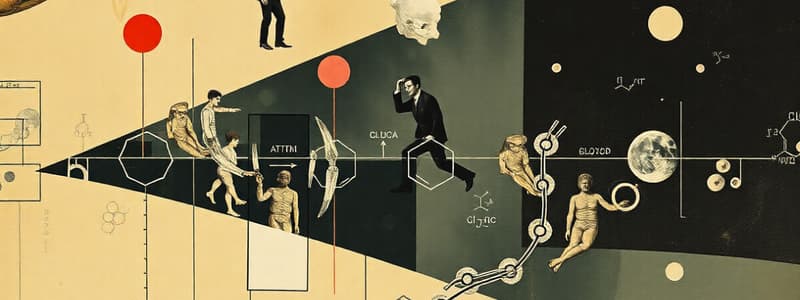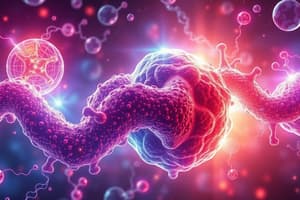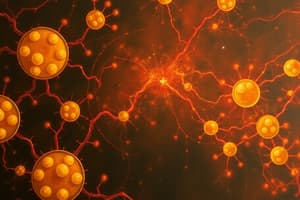Podcast
Questions and Answers
During glycogenolysis, which enzyme plays a crucial role in splitting glycogen branches to release glucose molecules?
During glycogenolysis, which enzyme plays a crucial role in splitting glycogen branches to release glucose molecules?
- Dehydrogenase
- Phosphorylase (correct)
- Coenzyme A
- Citrate synthase
If the complete oxidation of one gram-mole of glucose releases 686,000 calories of energy, and 12,000 calories are required to form one gram-mole of ATP, what best explains why the glycolytic pathway captures energy in small packets?
If the complete oxidation of one gram-mole of glucose releases 686,000 calories of energy, and 12,000 calories are required to form one gram-mole of ATP, what best explains why the glycolytic pathway captures energy in small packets?
- To ensure the maximal amount of energy is efficiently captured as ATP. (correct)
- To minimize the number of enzymes required for the process.
- To directly convert all available energy into mechanical work.
- To maximize energy loss as heat, maintaining optimal body temperature.
In glycolysis, glucose (a 6-carbon molecule) is split into two molecules of pyruvic acid (3-carbon molecules). What is the net gain of ATP molecules directly produced during this process from one molecule of glucose?
In glycolysis, glucose (a 6-carbon molecule) is split into two molecules of pyruvic acid (3-carbon molecules). What is the net gain of ATP molecules directly produced during this process from one molecule of glucose?
- 38 ATP molecules
- 4 ATP molecules
- 2 ATP molecules (correct)
- 6 ATP molecules
During the Krebs cycle, 24 hydrogen atoms are released per molecule of glucose. Given their origin, how many hydrogen atoms are released during the conversion of pyruvic acid to Acetyl-CoA?
During the Krebs cycle, 24 hydrogen atoms are released per molecule of glucose. Given their origin, how many hydrogen atoms are released during the conversion of pyruvic acid to Acetyl-CoA?
Considering the events in oxidative phosphorylation, what is the primary role of oxygen?
Considering the events in oxidative phosphorylation, what is the primary role of oxygen?
During the uptake of triglycerides into cells, what role does lipoprotein lipase play?
During the uptake of triglycerides into cells, what role does lipoprotein lipase play?
During dehydration synthesis, what is the role of water ($H_2O$) and energy?
During dehydration synthesis, what is the role of water ($H_2O$) and energy?
How are fatty acids transported through the body when they are needed for energy?
How are fatty acids transported through the body when they are needed for energy?
Which of the following best describes the role of ATP in coupled reactions within a cell?
Which of the following best describes the role of ATP in coupled reactions within a cell?
If a patient has a condition that impairs their ability to produce insulin, what direct effect would this have on glucose metabolism?
If a patient has a condition that impairs their ability to produce insulin, what direct effect would this have on glucose metabolism?
What percentage of fat cells in adipose tissue is typically composed of triglycerides?
What percentage of fat cells in adipose tissue is typically composed of triglycerides?
After being absorbed, fructose and galactose are converted into what compound within the liver?
After being absorbed, fructose and galactose are converted into what compound within the liver?
Before fatty acids can be oxidized for energy, triglycerides must undergo what initial process?
Before fatty acids can be oxidized for energy, triglycerides must undergo what initial process?
Why is phosphorylation of glucose immediately upon entry into a cell important for glucose metabolism?
Why is phosphorylation of glucose immediately upon entry into a cell important for glucose metabolism?
During beta-oxidation, fatty acids are converted into what molecule that then enters the citric acid cycle?
During beta-oxidation, fatty acids are converted into what molecule that then enters the citric acid cycle?
Which of the following metabolic states is LEAST likely to cause ketosis?
Which of the following metabolic states is LEAST likely to cause ketosis?
Which of the following hormones does NOT directly increase free fatty acid (FFA) levels by activating triglyceride lipase?
Which of the following hormones does NOT directly increase free fatty acid (FFA) levels by activating triglyceride lipase?
During oxidative phosphorylation, what are the two main processes involved in ATP production?
During oxidative phosphorylation, what are the two main processes involved in ATP production?
If a cell produces 4 ATP molecules through Glycolysis but uses 2 ATP molecules in the process, what is the net gain of ATP?
If a cell produces 4 ATP molecules through Glycolysis but uses 2 ATP molecules in the process, what is the net gain of ATP?
Under what conditions is lactic acid produced in cells?
Under what conditions is lactic acid produced in cells?
What happens to excess glucose in the body after glycogen stores are full?
What happens to excess glucose in the body after glycogen stores are full?
What is the primary trigger for gluconeogenesis?
What is the primary trigger for gluconeogenesis?
Which hormone stimulates the adrenal cortex to release cortisol during gluconeogenesis?
Which hormone stimulates the adrenal cortex to release cortisol during gluconeogenesis?
Why are lipids considered efficient for energy storage?
Why are lipids considered efficient for energy storage?
What are chylomicrons, and where are they absorbed after fat digestion?
What are chylomicrons, and where are they absorbed after fat digestion?
Which of the following processes are involved in cellular metabolism? (Select all that apply)
Which of the following processes are involved in cellular metabolism? (Select all that apply)
Which metabolic process involves the breakdown of glucose to produce energy?
Which metabolic process involves the breakdown of glucose to produce energy?
What are the primary metabolic pathways involved in cellular metabolism?
What are the primary metabolic pathways involved in cellular metabolism?
Flashcards
Metabolism
Metabolism
The sum of all chemical processes in a cell that allow life.
Anabolism
Anabolism
The process of building larger molecules from smaller ones, using energy.
Catabolism
Catabolism
The process of breaking down larger molecules into smaller units, releasing energy.
ATP (Adenosine Triphosphate)
ATP (Adenosine Triphosphate)
Signup and view all the flashcards
Glycogenesis
Glycogenesis
Signup and view all the flashcards
Glycogenolysis
Glycogenolysis
Signup and view all the flashcards
Glycolysis
Glycolysis
Signup and view all the flashcards
Citric Acid Cycle
Citric Acid Cycle
Signup and view all the flashcards
Oxidative Phosphorylation
Oxidative Phosphorylation
Signup and view all the flashcards
Energy Yield of Glycolysis
Energy Yield of Glycolysis
Signup and view all the flashcards
Lipoprotein lipase
Lipoprotein lipase
Signup and view all the flashcards
Fatty acids
Fatty acids
Signup and view all the flashcards
Adipose tissue
Adipose tissue
Signup and view all the flashcards
Beta-oxidation
Beta-oxidation
Signup and view all the flashcards
Ketosis
Ketosis
Signup and view all the flashcards
Triglycerides
Triglycerides
Signup and view all the flashcards
Phospholipids
Phospholipids
Signup and view all the flashcards
ATP Total from Glucose
ATP Total from Glucose
Signup and view all the flashcards
Anaerobic Glycolysis
Anaerobic Glycolysis
Signup and view all the flashcards
Glycogen Storage
Glycogen Storage
Signup and view all the flashcards
Gluconeogenesis
Gluconeogenesis
Signup and view all the flashcards
Lipid Metabolism
Lipid Metabolism
Signup and view all the flashcards
Chylomicrons
Chylomicrons
Signup and view all the flashcards
Study Notes
Chemical Reactions and Metabolism
- Metabolism are the chemical processes enabling cells to survive
- Key chemical reactions in cells center around obtaining energy from food and making it available for bodily functions
- Two main types of metabolism are anabolism (synthesis) and catabolism (breakdown)
Carbohydrate Metabolism and ATP Formation Chapter 69
- After absorption, fructose and galactose are quickly converted to glucose in the liver
- Glucose (C6H12O6) is the final pathway used by the body to transport carbohydrates into cells
Transport of Glucose Through Cell Membrane
- Glucose cannot passively enter cells, requiring active or facilitated transport with a carrier protein.
- Insulin plays a vital role in this process
Phosphorylation
- Glucose, upon entering a cell, combines with a phosphate radical forming glucose-6-phosphate.
- This glucose can be immediately used for energy or stored as glycogen in the liver and muscles
Glycogenesis
- The formation of glycogen, a storage form of glucose.
Glycogenolysis
- Breakdown of glycogen into glucose within the liver.
- It is a crucial process for maintaining glucose levels in the blood.
- Hormones like epinephrine and glucagon stimulate the process
Release of Energy from Glucose
- Glucose's breakdown occurs through several stages including glycolysis, the citric acid cycle, and the electron transport chain
- Each stage yields ATP, a source of energy for cellular functions
Glycolytic Pathway
- One molecule of glucose can release a large amount of energy (686,000 calories), but only 12,000 calories are needed to form ATP.
- Enzymes facilitate the gradual oxidation of glucose, optimizing the capture of energy as ATP.
- 38 moles of ATP are generated per mole of glucose
Glycolysis
- Glycolysis is the primary process for extracting energy from glucose
- Involves ten steps and occurs in the cytoplasm
- Glucose is broken down into two pyruvic acid molecules (3 carbons each)
- This process also produces ATP, a form of usable chemical energy.
Glycolysis (Continued)
- Net gain of ATP from one glucose molecule: 2 pyruvic acid molecules, 2 ATP molecules, and 4 hydrogen atoms.
- Efficiency of ATP formation is 43%.
- Pyruvic acid combines with Coenzyme A to form Acetyl-CoA, which produces 6 more ATP molecules later in the process
Citric Acid Cycle (Krebs Cycle)
- Occurs within the mitochondria
- Acetyl CoA combines with oxaloacetic acid forming citric acid (first product of the cycle).
- The cycle results in the continual production of oxaloacetic acid
- 24 hydrogen atoms are released for each glucose molecule
Citric Acid Cycle (Krebs Cycle) (Continued)
- 20 hydrogen atoms combine with NAD+ via dehydrogenase.
- During further stages, water is added and carbon dioxide and hydrogen atoms are released.
- 2 molecules of ATP are produced
Net Reaction per Molecule of Glucose in the Citric Acid Cycle
- The overall reaction involves Acetyl CoA, water, ADP, and CO2, resulting in the formation of CoA and ATP
Oxidative Phosphorylation
- Oxygen is essential to the process
- NADH within mitochondria is converted to NAD+ , H+, and electrons.
- The electrons initiate the Electron Transport Chain where energy is generated, captured as a proton gradient
- The resulting process is called chemiosmosis.
Energy production through oxidative phosphorylation
- A series of steps in the electron transport chain within the mitochondria produce considerable amounts of ATP
- The process captures energy from the reactions
Summary of ATP Formation
- Glycolysis produces 4 ATP (2 consumed), Citric Acid Cycle produces 2 ATP.
- The Electron Transport Chain produces 34 ATP, resulting in a total of 38 ATP.
- The efficiency of ATP production during glucose is roughly 66%.
- Feedback mechanisms regulate ATP production
Anaerobic Glycolysis
- This process yields a diminished amount of energy from glucose.
- Pyruvic acid combines with NADH and hydrogen to form lactic acid.
- Used as a measure of cellular oxygen usage and overall body efficiency
Storage of Glucose
- Glycogen stores are filled up first
- Excess is stored as fat
Gluconeogenesis
- The synthesis of glucose from non-carbohydrate sources (fatty acids and protein) when blood sugar is low.
- Low blood glucose triggers the release of cortisol, which initiates protein breakdown into amino acids for glucose formation
Lipid Metabolism Chapter 69
- Lipids are concentrated cellular energy sources.
- The most efficient way cells store energy
- Lipids include triglycerides (neutral fats), phospholipids, and cholesterol along with other lipids
Fatty Acids
- Fatty acids are long-chain hydrocarbon molecules containing a carboxylic acid group.
- Common types like palmitic acid have a particular structure
Triglycerides
- Triglycerides are structures with glycerol (a three-carbon alcohol) bonded to three fatty acids.
- A major storage form of lipids in animals.
Absorption of Fats
- Dietary triglycerides break down into monoglycerides and fatty acids within the intestines.
- The broken-down fats are reassembled into triglycerides, creating chylomicrons.
- Absorption into the lymphatic system occurs, and plasma appears cloudy one hour after high-fat consumption.
Uptake Into Cells
- Lipoprotein lipase in capillary cells breaks down triglycerides into fatty acids and glycerol.
- Fatty acids diffuse into cells
- Inside the cells, fatty acid resynthesizes into triglycerides and are then stored.
Transport Through Body
- When needed, fat cells liberate triglycerides into fatty acids and glycerol.
- These components combine with albumin, forming free fatty acids to be transported around the body
Fat Deposits
- Fat deposits are accumulations of adipose tissue in the body and liver
- Adipose tissue cells, or fat cells, are largely made of triglycerides, the body's primary form of lipid storage.
Use of Triglycerides for Energy
- Triglycerides provide a considerable portion of the energy in many diets
- Fatty acids and glycerol are products of triglycerides breakdown.
- Glycerol is converted for glucose breakdown, while fatty acids are oxidized in mitochondria
Beta-Oxidation
- Fatty acids are gradually converted into Acetyl-CoA via a process called beta-oxidation within the cell.
- This Acetyl-CoA then enters the Citric Acid (Krebs) cycle
- A substantial quantity of ATP is generated through this process, effectively exploiting fatty acids for cellular energy production.
Ketosis
- When the body lacks carbohydrates, fats are used for energy.
- This results in the production of ketone bodies, including B-hydroxybutyric acid, acetoacetic acid, and acetone.
- Possible causes include starvation, diabetes, and high-fat, low-carbohydrate diets.
Regulation of Fat Utilization
- Epinephrine and norepinephrine boost triglyceride lipase activity, significantly increasing FFA levels.
- Rate of fatty acid usage is influenced by: corticotropin release from the anterior pituitary, glucocorticoid release from the adrenal cortex, and less insulin secretion.
Phospholipids
- Phospholipids consist of a fatty acid, phosphoric acid, and a nitrogenous base.
- Types include lecithins, cephalins, and sphingomyelins.
- Essential components of cell membranes and lipoproteins.
Uses of Phospholipids
- Phospholipids are crucial components of cell membranes.
- They are constituents of lipoproteins and are involved in clotting (thromboplastin).
- Sphingomyelin forms myelin sheaths around nerve cells.
Uses of Cholesterol
- Cholesterol is involved in bile formation in the liver.
- It is a precursor to essential hormones such as estrogen, progesterone, and testosterone.
- Cholesterol is critical in forming the skin's protective outer layer.
Atherosclerosis
- A buildup of fatty deposits (plaques) in the arteries where fat and cholesterol are deposited.
- This leads to thickened and hard arteries, a condition also known as arteriosclerosis.
- Arterial blockages and potential ruptures may occur if this deposit persists
Factors Leading to Atherosclerosis
- Risk factors include physical inactivity, obesity, diabetes, hypertension, high lipids, and smoking.
Prevention of Atherosclerosis
- Key preventative measures include low-fat diets, smoking cessation, exercise, blood pressure and glucose control, and consumption of high-fiber options (e.g., oat bran).
- Prescription drugs, such as statins, inhibit cholesterol production.
Protein Metabolism Chapter 70
- Proteins comprise a substantial part of the body's structure.
- Proteins are made up of different amino acids linked together by peptide bonds and hydrogen bonds.
Protein Functions
- Proteins have various functions including structural roles, enzymatic action, oxygen transport, roles in nucleoproteins and in muscle contraction and cellular function.
Regulatory Proteins
- Regulatory proteins carry messages from chemical signals throughout the cell.
- These signaling molecules involve G protein-coupled receptors.
- Ligand binding is the initiating step, leading to downstream effects and impacting other body parts.
Transport of Amino Acids
- Digested proteins become free and separate amino acids in the gastrointestinal tract.
- The process of absorbing proteins into their constituent amino acids typically takes 2-3 hours.
- Amino acids enter the cells using active transport or facilitated diffusion.
- Excess amino acids are expelled via urine if their concentrations exceed renal reabsorption capacity.
Storage of Amino Acids
- Amino acids are quickly integrated into new proteins after entering body cells.
- When necessary, these amino acids are released and transported to the blood to resupply depleted resources.
Major Plasma Proteins
- Albumin regulates colloid osmotic pressure in the blood.
- Globulins are associated with metabolic processes and immune responses
- Fibrinogen is a crucial component in blood clotting
Dietary Amino Acids
- Ten amino acids are deemed essential, as the body cannot produce them.
- Ten others are deemed non-essential, as the body can synthesize them
Use of Proteins for Energy
- Protein breakdown to get energy happens in the liver.
- Deamination removes amino groups (-NH2) from amino acids.
- Enzymes called aminotransferases facilitate the deamination process
Urea
- The liver converts ammonia produced during deamination into urea.
- Ammonia is hazardous to neurons, making its removal essential.
- Urea is eliminated from the body through the kidneys.
Oxidation of Deaminated Amino Acids
- Following deamination, resulting keto acids are converted into substances that can enter the citric acid cycle.
- These substances can then be oxidized to generate ATP.
- The process of forming keto acids or fatty acids from amino acids is called ketogenesis
Obligatory Degradation of Proteins
- The body processes 20-30 grams of protein for degradation into amino acids for use and disposal.
- Protein deficiency will impact the functioning of the various organs.
- Carbohydrates save protein for functional purposes when adequate levels are present.
Hormonal Regulation of Protein Metabolism
- Growth hormone accelerates amino acid transport into cells for protein synthesis.
- Insulin aids amino acid cellular uptake, promoting protein generation.
- Glucocorticoids increase extrahepatic protein breakdown to increase amino acid availability.
- Testosterone supports protein deposition in muscles.
- Thyroxine helps accelerate metabolism, facilitating either catabolism or anabolism, depending on need.
Studying That Suits You
Use AI to generate personalized quizzes and flashcards to suit your learning preferences.
Related Documents
Description
This quiz covers key concepts in cellular metabolism, including glycogenolysis, glycolysis, the Krebs cycle, oxidative phosphorylation, and triglyceride uptake. Questions focus on enzyme functions, energy yields, and the roles of essential molecules like oxygen. Understanding these processes is important for comprehending how cells generate and utilize energy.




